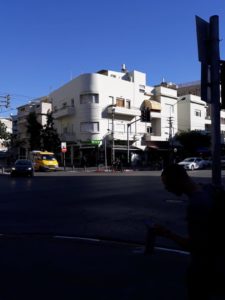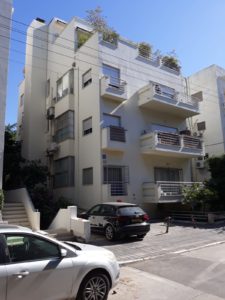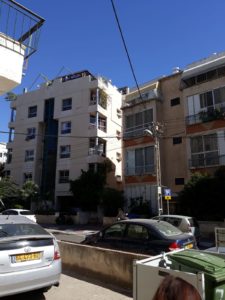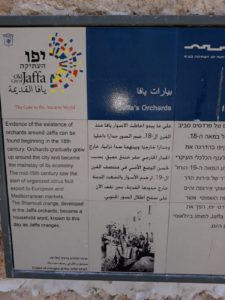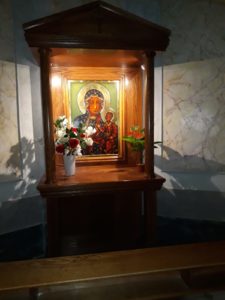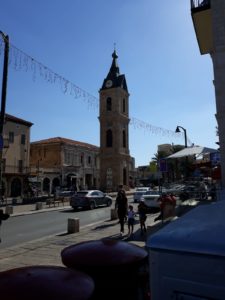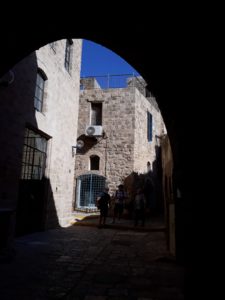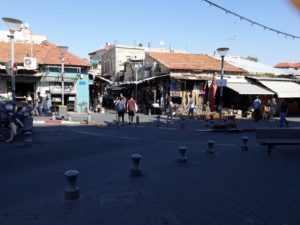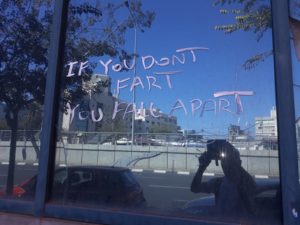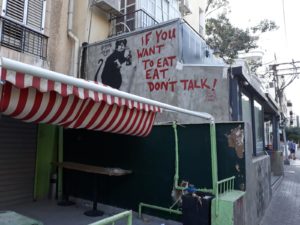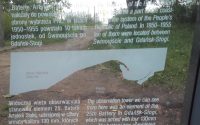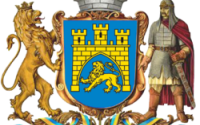Israel: Land of Our Lost Citizens Part 1: Tel-Aviv – The White City
It is to easy and for many, convenient, to omit the contribution to European culture that has been made by people of the Jewish faith. Every country has tried to airbrush them from European history unless it’s to mention the Holocaust. Jews are central to the story of Europe and no journey to trace my ancestry would be complete without an understanding of their vital contribution. I pay homage and my respects to our lost citizens. May you never be forgotten.
31.10.2018
I have no idea what to expect when I arrive in Tel Aviv-Yafo tomorrow. What I do have is a connection from my time at the Mackintosh School of Architecture in Glasgow, namely, Fred Selby who, without notes and holding the full attention of us students, lectured in Modern Architecture. As Manfred Salinger, he had studied at the Technical Institute in Berlin where his mentors just happened to be Walter Gropius and Erich Mendelssohn; two pioneers of the modern movement in architecture which burst on to the scene at the turn of the 20th century, coterminous with upheaval in the arts and politics and revolution.
As a German of the Jewish faith, he was forced to flee Germany when the Nazis grabbed power in Germany in 1933. Changing his name to Fred Selby he finally arrived in Britain and on to the Mackintosh where his specialist subject was the Bauhaus. Other German Jews arrived in Palestine built Tel-Aviv on Bauhaus principles among other styles from Europe. I will be interested to know how Israelis view Europe: indeed have they any views at all about it?I already know the profound mark they left on European culture so has modern day Israel reflected this contribution? One thing this visit has nothing to do with the political situation. For all the sympathy I have for the plight of Palestinians I’m not going to Israel to find this out for myself.
01.11.2018
On board the five hour flight from London to Tel Aviv, I’m sitting in an aisle seat with an English woman in the window seat and in the middle a Brazilian called Victor. He’s travelling on a Hungarian passport for which he was able to claim Hungarian citizenship through his grandfather and there’s me travelling on a Polish one. The English woman, who carries an Irish passport, is visiting her half sister who lives near Tel Aviv. The five hour flight is not as daunting as I imagined it might be. It’s the longest flight I’ve made in twenty eight years.
The English woman had warned us of the wait at Israel immigration control and what she said is completely true. Over one hour at passport control and waiting for a blue immigration pass granting a three month stay. You forget this is not the EU.
Ben Gurion Airport is located between Tel Aviv-Yafo and Jerusalem. Although it is early evening the drive from the airport to Tel Aviv confirms you are in a highly developed First World country. It could be any EU country. I don’t have any specific plans other than the Bauhaus tour tomorrow. Things start to close down or maybe wind down, so I was told, on Friday evenings in preparation for Sabbath which of course in the Jewish tradition is Saturday. Tel Aviv, being the most secular city of Israel might be a bit more relaxed about tradition.
If I can, I would like to find out more about the Germans and Poles of the Jewish faith who emigrated here. Do they still retain traits of their European ancestry?
02.11.2018
The hotel is located about fifty metres from the beach.
First full day and I’m getting used to seeing what Tel Aviv looks like in daylight as I head on foot to the Bauhaus Centre which is located not far from here on Dizengoff Street. I’m booked for a tour of the ‘White City.’ Virginia, our tour guide who originates from France, introduces the tour with a short film presentation about the origins of the city of Tel Aviv, as it is now. It begins in 1917 with the Balfour Declaration which aspired to grant people of the Jewish faith a homeland in the area in an around Palestine which was then part of the Ottoman Empire but which was about to become administered by the British after the Armistice that ended World War I and the downfall of the Ottoman Empire. The first Jewish migrants, largely from Russia settled around Yafo and were at first welcomed by the local Arabs and lived side by side. A trickle became a flood and tension ans outright violence soon followed. The Jewish inhabitants moved out to an area north of Yafo which became modern day Tel Aviv. It’s expansion coincided with the rise of Nazism in Germany and nationalism generally and in Central Europe in particularly. I would like to add here that the new city was planned by the innovative Scot Patrick Geddes, who introduced the concept of conurbation.

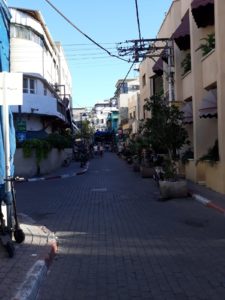
German architects of the Jewish faith became inspired by the ideals of the Modern Movement which arose in Germany and Belgium. In Germany the socialist ideals of art and architecture of the Bauhaus, founded by Walter Gropius, prepared the ground for Jewish refugees from Germany to build the new city of Tel Aviv on Bauhaus principles. And so the White City came into being. Thanks to the recent efforts in regeneration of Dr. Mischa Gross it is now a UNESCO World Heritage Site dedicated to the International Architecture Movement. The White City is an eclectic mixture of the styles of Walter Gropius, Hannes Meyer and most importantly Erich Mendelsohn, the latter’s expressionism evident in Israel. The original buildings displayed Art Nouveau and Art Deco styles and with the new arrivals from Germany, the Modernist Style. The Bauhaus Style was the most prevalent in accommodating non-religious migrants from Central and Eastern Europe. One aspect of the Bauhaus Style was its uninhibited emphasis on functionality at the expense of external ornamental embellishment. There are however a few buildings with external tile decoration around doorways which tell an interesting story. These were brought from Germany by Jewish migrants fleeing the excesses of the Nazis. These Germans had their assets confiscated by the Nazis. 33% was kept by the Nazi state apparatus while 66% was used to force the Jewish refugees to purchase German made building materials which the migrants shipped to Palestine. These materials were mainly ceramic tiles later used in bathrooms and around doorways in the apartment buildings of the White City. This turns out to be one of the most informative tours I’ve ever undertaken. Enjoy the photos.
I would like to find a museum dedicated to the Jewish emigration to Palestine and later Israel from Central and Eastern Europe. Photographic testimony would be interesting.
And so to Carmel Market and my first taste of ‘junam’ which is oven baked flatbread with a variety of fillings and I opt for the speciality based on chicken rather than lamb. All come with a salad and marinade with a mayonnaise I’ve never tried until now. One awesome mouthful after another and an appealing local beer to sip – l’chaim! What’s not to like!
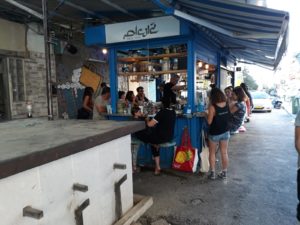

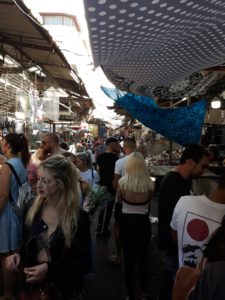

I’ve never seen such an amazing array of trash as is on display at the market.
The northern area of Tel Aviv is like any European City, in fact it’s probably out of place in the Middle East. It has virtually no history before 1917. The real history lies in the old city of Yafo which was the centre of life around here and which I’ll visit tomorrow.
03.11.2018
Shabbat – you’d hardly know it here in Tel Aviv. Only the public transport is not running and the city is soon gridlocked with cars and tourists like me heading to Yafo. I have decided after all to spend a day in Jerusalem, on Monday. After all it’s only 70 km from Tel Aviv, I had thought it was much further.
Don’t always trust Google Maps; just because something says TRAIN STATION doesn’t always mean it is a building where rolling stock stops on railway lines. In this case it means a gym. And so I try again because I will take the train from Tel Aviv to Jerusalem. I don’t know what way I’ve come but it’s through the poorer areas of Tel Aviv which seem to be populated mostly by Arabs and Africans, the latter I guess might be Falashas – Ethiopians of the Jewish faith; a sect recognised as genuinely Jewish.
The media conditions you to believe that these are bad areas and no matter how much you claim not be racist, that media conditioning ignites a completely unjustifiable fear. Many of the Arabs and Africans are standing around in groups that passed me without looking or said the Hebrew greeting ‘Shalom’. Shocking to say but I am glad to see Israeli faces again as I near Yafo. If ever there was a lesson in finding things out for yourself without background information prejudicial then this was it. Another lesson in the pernicious power the media is capable of wielding.
Entering the Old City of Yafo, which dates back to over 2,000 years is quiet an experience. With its narrow alleys and steep steps leading up from the port, you relive history in your mind and the most obvious, apart from its mention in the Bible, for us from the Christian World is the Crusades. How we were inculcated with deeds of heroism by these gallant soldiers of Christ as they freed the holy places from ‘infidel and barbarian Saracens’ who we were told cut Christian babies to pieces and fed them to the dogs. Oh how as kids we hated the Muslims fed as we were by such salacious lies and propaganda. The reality was somewhat different. No doubt the majority of the Crusaders were well meaning and pious and joined the Crusade with the best of intentions but others were murderers and scoundrels who with the Papal promise of immediate redemption of all sins and by-passing Purgatory on Route 1 to Heaven carried on as before in robbery, rape all unburdened by any conscience. In all likelihood it was a minority but how would the inhabitants of Yafo feel as the witnessed this drunken minority pouring off their ships and about to go on a trail of pillage, slaughter, rape and sexually transmitted disease? What kind of memory of the Crusaders would have been passed down? – and by the way the same might well have applied to the Saracens. Take everything you’ve been told with a pinch of salt and find out for yourself.

You can easily spend the whole day in Yafo. Synagogues, mosques, Orthodox and Roman Catholic churches stand in close proximity to each other. St.Peter’s Roman Catholic church holds a complete surprise. In a side chapel on the wall hangs a painting of Our Lady of Częstochowa – totally unexpected until you remember that the original painting may well have originated in the middle east. Anyway it bears to two slash marks on the face so it is relatively recent in origin. Wonderful panoramic views of Tel Aviv from the highest point on the hill atop Yafo. Enjoy these photos of Yafo.
I was unable, yesterday evening, to eat in a recommended restaurant specialising in Ashkenazi cuisine from Poland but this evening, I have been successful and it’s been well worth it. The restaurant is named ‘KETON’.
04.11.2018
I don’t intend to do very much today as I’ve a long day ahead of me tomorrow – an all-day organised trip to Jerusalem. Following enquiries among locals, I’m advised not to take the train from Tel Aviv to Jerusalem. Whilst it is a picturesque journey through the mountains, the main station is not near the sites of the Old City. No time to be adventurous as I’ve only a day and so I’ve organised a visit through a very useful app called ‘Get Your Guide’.
I did not get to the Flea Market in Yafo yesterday, so that’s my target for today, eat earlier and prepare for tomorrow. As with any modern city, plenty of street humour.
The Museum of the Jewish People which might have provided photographic testimony of the Jewish emigrants from Central and Eastern Europe is partially closed for a re-fit. The section which might have housed what I am looking for is part of the re-fit.
Part 2 follows next week
End
